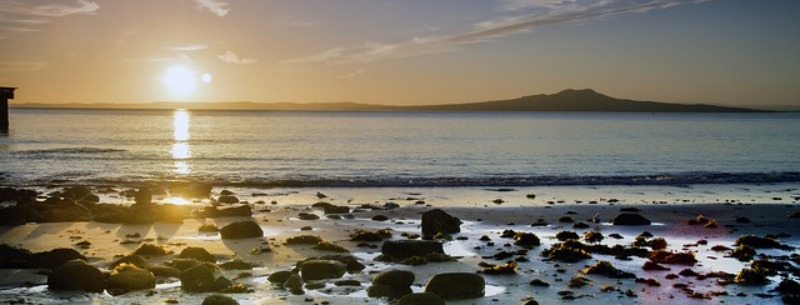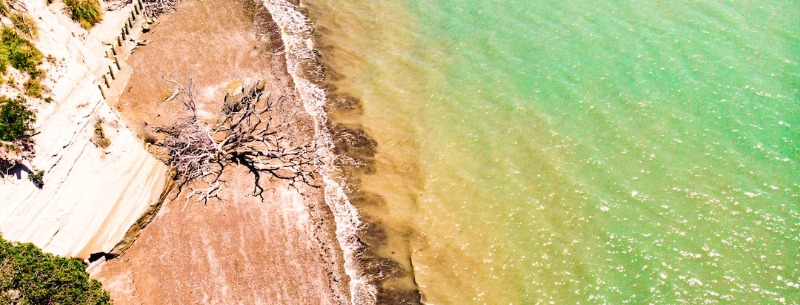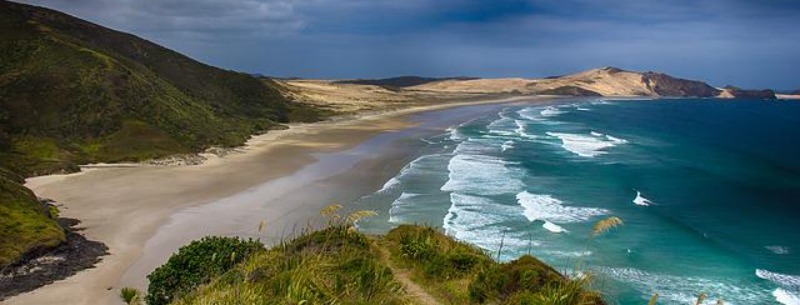New Zealand Beaches Vacation Guide
New Zealand comes with a reputation as a unique land packed with magnificent, raw scenery: craggy coastlines, sweeping beaches, primeval forests, snow-capped alpine mountains, bubbling volcanic pools, fast-flowing rivers and glacier-fed lakes, all beneath a brilliant blue sky.
All of this provides a canvas for boundless diversions, from moody strolls along windswept beaches and multi-day tramps over alpine passes to the adrenalin-charged adventure activities of bungy jumping and whitewater rafting. In fact, some visitors take on New Zealand as a kind of large-scale assault course, aiming to tackle as many adventures as possible in the time available.
Auckland Beach Vacation
Auckland’s urban sprawl completely smothers the North Island’s wasp waist, a narrow isthmus where the island is all but severed by river estuaries probing inland from the city’s two harbors. To the west, the shallow and silted Manukau Harbour opens out onto the Tasman Sea at a rare break in the long string of black-sand beaches continually pounded by heavy surf. Maori named the eastern anchorage the Waitemata Harbour for its “sparkling waters”, which constitute Auckland’s deep water port and a focus for the heart of the city. Every summer weekend the harbor and adjoining Hauraki Gulf explode into a riot of brightly-colored sails.

Auckland’s beaches are commonly categorized by area — east, west, or north. The eastern beaches, such as those along Tamaki Drive on the south side of the harbor, are closer to the city and don’t have heavy surf. They usually have playgrounds and changing facilities. Judge’s Bay and Mission Bay are particularly recommended for their settings. The best swimming is at high tide.
West-coast black-sand beaches are popular in summer. They tend to have bare-bones facilities, but many have changing sheds near the parking areas. However, the sea is often rough, and sudden rips and holes can trap the unwary. Lifeguards are on duty, and the safe swimming areas are marked with flags. The most visited of these beaches is Piha, some 40 km (25 mi) west of Auckland, which has pounding surf as well as a sheltered lagoon dominated by the reclining mass of Lion Rock.
Whatipu, south of Piha, is a broad sweep of sand offering safe bathing behind the sandbar that guards Manukau Harbour. To get to the west-coast beaches, head to Titirangi and take the winding road signposted as “The Scenic Drive.” Once you are on that road, the turnoffs to individual beaches are well marked — and, as advertised, there are lots of beautiful harbor views. Across Waitemata Harbour from the city, a chain of magnificent beaches stretches north as far as the Whangaparoa Peninsula, 40 km (25 mi) from Auckland. Taking Highway 1 north and keeping an eye peeled for signs, for instance, you’ll reach Cheltenham, just north of Devonport.
Christchurch Beach Vacation
Capital of the Canterbury region and the largest city on the South Island, Christchurch (population 300,000) exudes a palpable air of gentility and a connectedness with the mother country.
Modern Christchurch is a lively melting pot of cultures, with a continental cafe scene and a distinct, ever-changing Kiwi identity of its own. Indeed, those who regard Christchurch as a quiet place in which to sleep off jet lag or take a break from the long journey across the South Island will be pleasantly surprised by the city’s contemporary face.
In recent years its traditional conservatism has gained a more youthful, bohemian edge, with an explosion of lively bars and restaurants, the emergence of underground nightlife, and a burgeoning of the visual arts, theatre, music and street entertainment. Such urban pursuits are nicely balanced by the Pacific Ocean suburbs of New Brighton and Sumner, both of which boast excellent beaches.

As the summer sun bakes the city streets it’s very tempting to head for the beach, and Christchurch has plenty on offer; all accessed by frequent buses, and with a choice of places to stay and eat if you fancy spending some time out there.
Around eight kilometers east of the center a long swathe of sand runs from Waimari Beach south along a spit to the mouth of the Avon estuary – the whole area is a great place to swim or simply lounge on a towel. The center of activity is New Brighton (bus #5, #6 or #29 from the city), locally famed in the 1970s and early 1980s for its Saturday shopping in the days when nowhere else was open at weekends.
Marine Parade runs north from here, close to Queen Elizabeth II Park, an impressive stadium built for the 1974 Commonwealth Games sited at the corner of Travis Road and Bower Avenue, about 500m inland. The complex contains an Olympic-sized swimming pool (Mon-Fri 6am-9pm, Sat & Sun 7am-6pm), and a children-oriented fun park (same times), which offers distractions such as mini-golf, mini-racing cars and mini-bikes.
South of New Brighton, a spit of land provides shelter for the waters of the Avon and Heathcote river estuary, which is backed by the quiet suburb of Bromley and the Te Huingi Manu and Te Huingi Martu wildlife reserves (daily dawn-dusk; free), a great place for bird watchers. The estuary basin provides an excellent spot for windsurfing and dinghy sailing.
Redcliffs Beach
Redcliffs is significant mainly as the starting point for the 5km-long Barnett Park Walkway (1hr 45min round-trip), which begins at a car park just off Main Road.
A well-formed track climbs through grassland onto rock outcrops, with steps giving access to a large rock shelter and several caves.
The walkway then bisects a copse of native bush and passes a seasonal waterfall, before crossing a creek and descending via bluffs past Paradise Cave, home of a Maori family in the 1890s.
Summer Beach
As you follow the coast around from Redcliffs you pass the river mouth, and estuary beaches become sea beaches, the best being at Sumner , a Norfolk Pine-backed strip of craft shops, restaurants, cafes, wine bars, surf shacks and a cinema, all fronting a broad patch of golden sand.
Named after Dr J.B. Sumner, Archbishop of Canterbury and president of the Canterbury Association in the 1850s, it’s now one of Christchurch’s more desirable suburbs and a popular destination on summer weekends.
The highlight of the beach is Cave Rock, a geological anomaly of honeycombed rock – its underside is peppered with little caves like an enormous Swiss cheese – which you can walk through at low tide.
You can also clamber up the rock to reach the lifeguard’s lookout point on top.
More or less opposite Cave Rock on the other side of Main Road, is a small, untidy and much-graffitied moa cave, where bones from these now-extinct flightless birds were discovered.
Most interesting of all, though, are a series of short walks to and around Sumner Head – a must if you lack the time to explore the Banks Peninsula further south.
